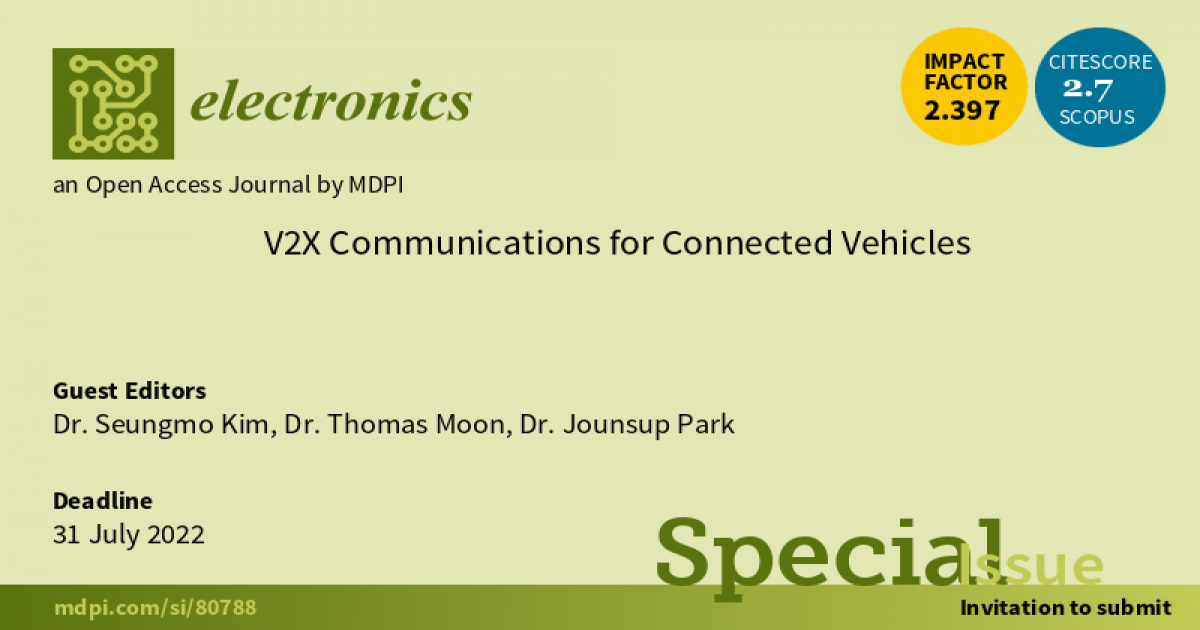- 2.6Impact Factor
- 6.1CiteScore
- 17 daysTime to First Decision
V2X Communications for Connected Vehicles
This special issue belongs to the section “Electrical and Autonomous Vehicles“.
Special Issue Information
Dear Colleagues,
Intelligent transportation systems (ITS) are no longer a concept from science fiction; rather, they are imminent, if not already integrated, in our everyday life. As enabling technology for most traffic-related issues ranging from in-vehicle entertainment to safety-critical applications, vehicle-to-everything (V2X) communications are considered to be one of the core technologies enabling ITS. Meanwhile, due to the dynamic nature of a V2X environment, mainly attributed to the mobility of vehicles, the development of V2X communications has raised a plethora of interesting research questions. As an effort to expedite the public’s understanding of the V2X communications, we are delighted to announce this Special Issue, where we look forward to receiving interesting ideas from you.
We welcome the submission of any unpublished original research related to the theme of “Vehicular Networks and Communications”. The articles are encouraged to discuss the following topics but are not limited to:
- V2X Communications, V2V, V2R, V2P, V2I, V2S;
- Radar, LIDAR, SONAR;
- Augmented Reality, Virtual Reality;
- Routing, Data Dissemination, Data Aggregation, Path Section, Optimization;
- Medium Access Protocols, Congestion Control, Prioritization Techniques;
- Green Computing, Energy Consumption, Energy Harvesting, Lifetime Maximization;
- Secure Communications, Security Optimization, Distributed Security;
- Privacy Preservation, Privacy Loss;
- Video Transmission, Video Encoding/Decoding, Video Compression;
- Edge Computing, Fog Computing, Cloud Computing, Distributed Computing;·
- Localization, Geographic, GPS outage, GPS free, GPS-assisted;
- Propagation Modelling, Interference, Path Loss Modelling.
Dr. Seungmo Kim
Dr. Thomas Moon
Dr. Jounsup Park
Guest Editors
Manuscript Submission Information
Manuscripts should be submitted online at www.mdpi.com by registering and logging in to this website. Once you are registered, click here to go to the submission form. Manuscripts can be submitted until the deadline. All submissions that pass pre-check are peer-reviewed. Accepted papers will be published continuously in the journal (as soon as accepted) and will be listed together on the special issue website. Research articles, review articles as well as short communications are invited. For planned papers, a title and short abstract (about 250 words) can be sent to the Editorial Office for assessment.
Submitted manuscripts should not have been published previously, nor be under consideration for publication elsewhere (except conference proceedings papers). All manuscripts are thoroughly refereed through a single-blind peer-review process. A guide for authors and other relevant information for submission of manuscripts is available on the Instructions for Authors page. Electronics is an international peer-reviewed open access semimonthly journal published by MDPI.
Please visit the Instructions for Authors page before submitting a manuscript. The Article Processing Charge (APC) for publication in this open access journal is 2400 CHF (Swiss Francs). Submitted papers should be well formatted and use good English. Authors may use MDPI's English editing service prior to publication or during author revisions.

Benefits of Publishing in a Special Issue
- Ease of navigation: Grouping papers by topic helps scholars navigate broad scope journals more efficiently.
- Greater discoverability: Special Issues support the reach and impact of scientific research. Articles in Special Issues are more discoverable and cited more frequently.
- Expansion of research network: Special Issues facilitate connections among authors, fostering scientific collaborations.
- External promotion: Articles in Special Issues are often promoted through the journal's social media, increasing their visibility.
- e-Book format: Special Issues with more than 10 articles can be published as dedicated e-books, ensuring wide and rapid dissemination.

